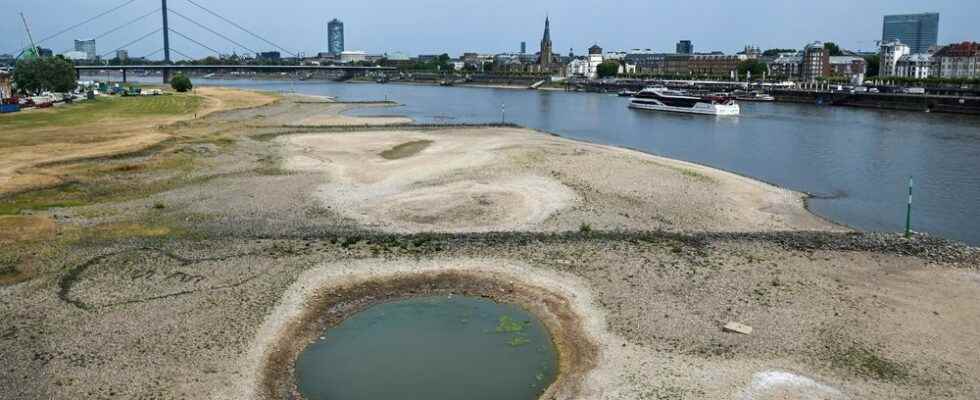The Loire, the Garonne, the Rhine, the Thames… Everywhere in Europe the rivers show particularly low flows, while the heatwave episode continues in Western Europe. With a flow that does not exceed 95 m3 per second on the hydrometric station of Montjean-sur-Loire (Maine-et-Loire), against 220m3 on July 13, the Loire is particularly suffering.
Wednesday August 10, 2022, as reported West France, the Maine-et-Loire prefecture has brought together an “exceptional departmental water committee”, bringing together communities, professional and agricultural players, associations and drinking water managers, to take stock of the situation of water resources in the Department. Unsurprisingly, the situation is getting worse. The flow of the Loire, in particular, passed “at the end of last week the heightened alert threshold”, indicates the prefecture.
If “the river is not dry” and if the “current flow is not historically abnormal”, however, “it is compared to recent decades. Since 1976, the Loire has not fallen below 100 m3/ s at Montjean only three times: 1991, 2019 and 2022”, explains on Twitter Thibault Laconde, engineer specializing in climate risks and founder of Callendar, a start-up specializing in climate risk assessment. “The flow of the Loire is very reduced, on certain sections at its lowest level since 1976”, he adds, while many photos of a river almost dry in certain places have been published on social networks these last days.
The situation is also described as “tense” for the small size dedicated to yachting. Waterways of France (VNF) reports “more or less large closures” of canals, particularly in the Grand Est and in Burgundy: Marne-Rhine canal, Ardennes canal, Vosges canal, canal between Champagne and Burgundy, Canal de la Meuse, Canal de Bourgogne… In all, 579 km of canals were closed, according to a score from Voies navigables de France (VNF) dated August 2.
In mainland France, 93 departments out of 96 are currently subject to water use restrictions to varying degrees: 22 are on “enhanced alert”, which imposes significant reductions in watering and withdrawals for agriculture. , even bans on certain withdrawals, and 68 are “in crisis”, where even water withdrawals for agriculture are prohibited. July 2022 was the second driest month ever recorded in France, after March 1961, with a rainfall deficit of around 84% compared to normal for the period 1991-2020.
In Germany, the low waters of the Rhine worsen the energy crisis
The Rhine also has particularly low water. On this river, the boats must be lightened by a third because of “problems of sinking”, warned Voies navigables de France. In western Germany, the lack of water due to the peak summer heat is making the Rhine difficult to navigate, posing an additional threat to an already weakened German economy.
The prospect of a partial shutdown of river traffic on this river, one of the busiest in the world, is a new headache for German industry, already hit by the Russian gas crisis and soaring energy prices due to of the Russian invasion of Ukraine.
The partially dry Rhine bed, July 25, 2022 in Düsseldorf, Germany
afp.com/Ina FASSBENDER
About 4% of freight is transported by sea in Germany, including on the Rhine, which originates in Switzerland and passes through several countries, including France and Germany, before emptying into the sea in the Netherlands. In Kaub, about 30 kilometers south of Koblenz, the reference level should even drop below 40 cm by the end of the week, which would have the effect of compressing traffic even further.
The giant Uniper said the low level of the Rhine could lead to “irregular operation” of two of its coal-fired power stations in September. EnBW, which operates sites in the Baden-Württemberg region (southwest), also warned that coal deliveries could be limited.
Another example of the current exceptional situation in Europe: the source of the Thames, in the United Kingdom, is dry and the river which crosses London does not begin to flow until about eight kilometers further downstream. Never seen. For miles downstream, the course of this emblematic river of the United Kingdom is best summed up in a few muddy puddles, a striking image of the drought that overwhelms a large part of the country.
The shell of a dead crayfish in the dry source bed of the Thames on August 8
afp.com/ADRIAN DENNIS
“We have never seen it so dry and empty,” Andrew Jack, a 47-year-old territorial official who lives about fifteen kilometers from Ashton Keynes, a village located a few kilometers from the source, told AFP. The hydrological agency warned on Tuesday August 9 that river levels were “likely to remain” exceptionally low in central, southern and eastern England “through October.
England experienced an exceptionally dry winter and spring, made worse by the driest July since 1935, if ever recorded in the South. Hinting at a worsening, the Met Office – Britain’s weather services – issued a heat orange alert on Tuesday for the south of England and east Wales between Thursday and Sunday, with temperatures reaching 35 to 36 degrees. The heat should remain less extreme than in July, when a peak temperature was recorded at more than 40 degrees Never seen – yet – in the United Kingdom.
